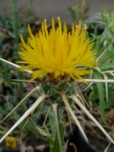Trait evolution during a rapid global weed invasion despite little genetic differentiation

New research just published by Dr Adrian Brennan and a team of researchers: Invasive species often possess a great capacity to adapt to novel environments in the form of spatial trait variation, as a result of varying selection regimes, genetic drift, or plasticity.
We explored the geographic differentiation in several phenotypic traits related to plant growth, reproduction, and defense in the highly invasive Centaurea solstitialis by measuring neutral genetic differentiation (FST), and comparing it with phenotypic differentiation (PST), in a common garden experiment in individuals originating from regions representing the species distribution across five continents. Native plants were more fecund than non-native plants but the latter displayed considerably larger seed mass. We found indication of divergent selection for these two reproductive traits but little overall genetic differentiation between native and non-native ranges. The native versus invasive PST – FST comparisons demonstrated that, in several invasive regions, seed mass had increased proportionally more than the genetic differentiation. Traits displayed different associations with climate variables in different regions. Both capitula numbers and seed mass were associated with winter temperature and precipitation and summer aridity in some regions. Overall, our study suggests that rapid evolution has accompanied invasive success of C. solstitialis and provides new insights into traits and their genetic bases that can contribute to fitness advantages in non-native populations.
Further Information:
Read the full publication in Evolutionary Applications here
Find out about the Department of Biosciences at Durham University
Visit Dr Adrian Brennan's staff page at Durham University.

